New York
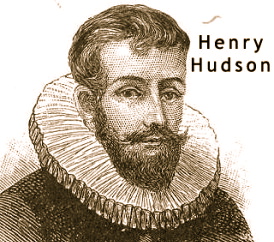
New York: A Documentary Film – Episode One: The Country and The City (1609-1825) Part-1
New York Documentary directed by Ric Burns.
New York: A Documentary Film – Episode One: The Country and The City (1609-1825) Part-2
New York Documentary directed by Ric Burns
Timeline of New York: 1500’s – 1600’s
- (1524) Giovanni da Varrazano of France, sailed into New York Harbor
 (1609) Henry Hudson explored Hudson River; Samuel de Champlain exlored northeastern New York
(1609) Henry Hudson explored Hudson River; Samuel de Champlain exlored northeastern New York- (1621) Dutch West Indian Company established New Netherland
- (1626) Dutch purchased Manhattan Island from local Indians
- (1664) English conquered New Netherland, changed name to New York
- (1673) Anglo-Dutch war occurred; Dutch captured New Amsterdam
- (1674) English recaptured New Amsterdam; English and Dutch arrived at peace agreement; New Amsterdam named New York City
1700’s
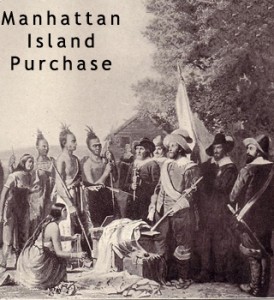 (1702) Yellow fever epidemic killed over 500
(1702) Yellow fever epidemic killed over 500- (1765) Conference held in New York City regarding Stamp Act
- (1774) Colonists disguised as Indians dumped load of tea into harbor
- (1775) American Revolution began; Ethan Allen and Benedict Arnold took Fort Ticonderoga; New York City shelled by British man-of-war
- (1776) New York declared independence from England; Nathan Hale hung for spying; Declaration of Independence endorsed; fire in New York City destroyed 1,000 homes
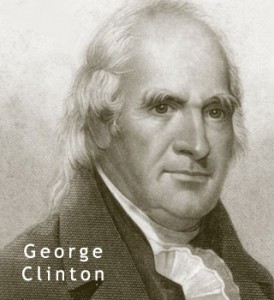 (1777) First constitution adopted; George Clinton elected governor
(1777) First constitution adopted; George Clinton elected governor- (1783) Battle of Saratoga occurred; British troops left New York City; Revolutionary War ended
- (1785) New York City named nation’s capitol
- (1788) New York became 11th state
- (1789) George Washington inaugurated as first U. S. president in New York City
- (1792) New York Stock Exchange founded
- (1795) Yellow fever epidemic killed 732
- (1796) Coffee House Slip Fire destroyed about 50 buildings near Murray Wharf
- (1797) Albany named state capitol
- (1798) Great epidemic killled 2,086
- 1800’s
- (1802) West Point Military Academy opened
- (1812-15) War of 1812 occurred
- (1825) Erie Canal completed
- (1827) Slavery abolished in New York
- (1831) New York’s first railroad opened
- (1835) Fire in NYC financial district destroyed more than 600 buildings
- (1871) Explosion on Staten Island Ferry Westfield II killed 125
- (1876) Stage fire at Brooklyn Theater killed 276
- (1883) Brooklyn Bridge opened
- (1886) Statue of Liberty dedicated
- (1888) Great Blizzard of ’88 paralyzed eastern seaboard
- (1896) Nine-day heatwave in NYC killed 420
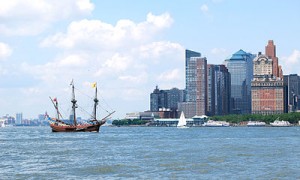 The history of New York begins around 10,000 BC, when the first Native Americans arrived. By 1100 AD, New York’s main tribes, the Iroquoian and Algonquian cultures, had developed. New York was discovered by the French in 1524 and first claimed in 1609 by the Dutch. As part of New Netherland, the colony was important in the fur trade and eventually became an agricultural resource thanks to the patroon system. In 1664, England renamed the colony New York, after York in Yorkshire. New York City gained prominence in the 18th century as a major trading port in the Thirteen Colonies.
The history of New York begins around 10,000 BC, when the first Native Americans arrived. By 1100 AD, New York’s main tribes, the Iroquoian and Algonquian cultures, had developed. New York was discovered by the French in 1524 and first claimed in 1609 by the Dutch. As part of New Netherland, the colony was important in the fur trade and eventually became an agricultural resource thanks to the patroon system. In 1664, England renamed the colony New York, after York in Yorkshire. New York City gained prominence in the 18th century as a major trading port in the Thirteen Colonies.
New York played a pivotal role during the Revolutionary War. The Battle of Saratoga was the turning point of the war. New York’s constitution was adopted in 1777, and strongly influenced the United States Constitution. New York City was the national capital at various times between 1785 and 1790, and Albany became the permanent state capital in 1797. New York was the eleventh state admitted to the Union, in 1787.
New York hosted significant transportation advancements in the 19th century, including the first steamboat line in 1807, the Erie Canalin 1825, and America’s first regularly scheduled rail service in 1831. These advancements led to the expanded settlement of western New York.
Far from any of its battles, New York sent the most men and money to support the Civil War. Thereafter, the state helped create the industrial age and consequently was home to some of the first labor unions.
During the 19th century, New York City became the main entry point for European immigrants to the United States. Millions came through Castle Clinton in Battery Park before Ellis Island opened in 1892 to welcome millions more. The Statue of Liberty opened in 1886 and became a symbol of hope. New York boomed during the Roaring Twenties, before the Wall Street Crash of 1929. New York City hosted the tallest building in the world from 1913–74.
World War II turned around the state’s economy, as hundreds of thousands worked to defeat the Axis powers. Following the war, the state experienced significant suburbanization, and most cities shrank. The Thruway system opened in 1956, signalling another era of transportation advances.
Following a period of near–bankruptcy, New York City renewed its stature as a cultural center, attracted more immigration, and hosted the development of new music styles. The City became a media capital over the second half of the 20th century, hosting most national news channels and broadcasts, as well as globally–renowned national newspapers. The state’s manufacturing base eroded over the period, as the state transitioned into service industries.
The September 11 attacks destroyed the World Trade Center, killing almost 3,000 people; they were the largest terrorist attacks on United States soil.
Prehistory
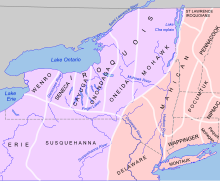 New York was dominated by Iroquoian (purple) and Algonquian (pink) Indian tribes.
New York was dominated by Iroquoian (purple) and Algonquian (pink) Indian tribes.
The first peoples of New York are estimated to have arrived around 10,000 BC. Around 800 AD, Iroquois ancestors moved into the area from the Appalachian region. The Point Peninsula Complex, the predecessors of the Algonquian peoples of New York. By around 1100, the distinct Iroquoian and Algonquian cultures that would eventually be encountered by Europeans had developed. The Iroquois were the most notable New York Indians; they used their dominance over the fur trade as a bargaining chip with Europeans, while other New York tribes were typically at the mercy of either European destruction or assimilation within the Iroquoian confederacy. Algonquian tribes were less united with neighboring peoples and typically lived along rivers, streams, or the Atlantic Coast. Despite European beliefs at the time, the natives were well-established peoples with sophisticated cultural systems. The natives had “a complex and elaborate native economy that included hunting, gathering, manufacturing, and farming…[and were] a mosaic of Native American tribes, nations, languages, and political associations.”
New Netherland
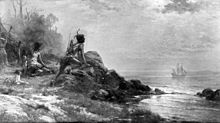 A native looks over New York Harbor to see the arrival of Henry Hudson in 1609.
A native looks over New York Harbor to see the arrival of Henry Hudson in 1609.
The first European to visit New York was Giovanni da Verrazzano in 1524. The Dutch claimed the land in 1609 following Henry Hudson‘s search for a Northwest Passage. In 1614 the Dutch–built Fort Nassau, the first European settlement, in present-day Albany. Fort Orange replaced it in 1624. Fort Amsterdam was built in 1626 at Manhattan Island‘s southern tip. The resulting town of New Amsterdam became the largest settlement in New Netherland. During its early decades, the colony was dependent on the fur trade. The patroonship of Rensselaerswijck—a feudal manor surrounding Fort Orange—developed an agricultural industry. By the 1650s, under the leadership of Director Peter Stuyvesant, the colony was a main exporter of tobacco, wheat, and lumber; most of these commodities came through the village of Beverwijck, Albany’s precursor.
British colonial period
A surprise attack with overwhelming force allowed the English to conquer New Netherland in 1664; lenient terms of surrender most likely kept local resistance to a minimum. The colony and city were both renamed New York (and “Beverwijck” was renamed Albany) after its new proprietor, James II of England, who was the Duke of York and Duke of Albany at the time. The population of New Netherland at the time of English takeover was 7–8,000.
Province of New York
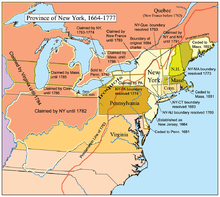 Map of the Province of New York
Map of the Province of New York
Large manors emerged during the 18th century, including Livingston, Cortlandt, Philipsburg, and Rensselaerswyck. The manors represented more than half of the colony’s undeveloped land. The Province of New York thrived during this time, its economy strengthened by Long Island and Hudson Valley agriculture, in conjunction with trade and artisanal activity at the Port of New York; the colony was a breadbasket and lumberyard for the British sugar colonies in the Caribbean. New York’s population grew substantially during this century: from the first colonial census (1698) to the last (1771), the province grew ninefold, from 18,067 to 168,007. Europe, including English, Scottish, Palatine German, and Irish immigrants, was the main source, though the slave trade brought in many Africans. New York at one time had the largest African slave population north of the Mason-Dixon Line; the group peaked in 1720 at 16% of New York’s population.
Merchant and landlord factions dominated New York’s political scene. Manorial families also had significant influence over the government. The colony was the center of conflicts between the British and French throughout the 18th century. The French and Indian Wars raged on and off for more than 70 years. New York was one of only two colonies that regularly housed British troops before 1755. The fighting pitted the native bands against each other, as the Europeans formed expedient alliances with them. Even during wars, the colonists sought control of Iroquoia, while the confederacy strained to stay together. Regardless of the Covenant Chain, the British and French continued to expand into Indian land; the French eventually found themselves being punished by the Iroquois through bloody raids in 1701 that forced the French to briefly retreat.
Revolution
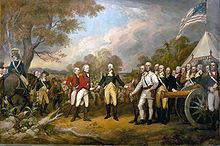 John Trumbull‘s Surrender of General Burgoyne stylizes the American win at Saratoga.
John Trumbull‘s Surrender of General Burgoyne stylizes the American win at Saratoga.
New York played a pivotal role in the Revolutionary War. The colony verged on revolt following the Stamp Act of 1765, advancing the New York City–based Sons of Liberty to the forefront of New York politics. The Act exacerbated the depression the province experienced after unsuccessfully invading Canada in 1760. Even though New York City merchants lost out on lucrative military contracts, the group sought common ground between the King and the people; however, compromise became impossible as of the April 1775 Battles of Lexington and Concord.
New York’s location made it key to control of the colonies. England assembled the century’s largest fleet: at one point 30,000 British sailors and soldiers anchored off Staten Island. General George Washington barely escaped New York City with his army in January 1776; General Sir William Howe was successful in driving Washington out, but erred by expanding into New Jersey. By January 1777, he retained only a few outposts near New York City. The British held the city for the duration, using it as a base for expeditions against other targets.
In October 1777, American General Horatio Gates won the Battle of Saratoga, later regarded as the war’s turning point. Had Gates not held, the rebellion might well have broken down: losing Saratoga would have cost the entire Hudson–Champlain corridor, which would have separated New England from the rest of the colonies and split the future union.
Statehood to the Civil War
Upon war’s end, New York’s borders became well–defined: the counties east of Lake Champlain became Vermont and the state’s western borders were settled by 1786.
Many Iroquois supported the British (typically fearing future American ambitions). Many were killed during the war; others went into exile with the British. Those remaining lived on twelve reservations; by 1826 only eight reservations remained, all of which survived into the 21st century.
The state adopted its constitution in April 1777, creating a strong executive and strict separation of powers. It strongly influenced the federal constitution a decade later. Debate over the federal constitution in 1787 led to formation of the groups known as Federalists—mainly “downstaters” (those who lived in or near New York City) who supported a strong national government—and Antifederalists—mainly upstaters (those who lived to the City’s north and west) who opposed large national institutions. In 1787, Alexander Hamilton, a leading Federalist from New York, wrote the first essay of the Federalist Papers. He published the series in New York City newspapers in support of the proposed United States constitution. Antifederalists were not swayed by the arguments, but the state ratified it in 1788.
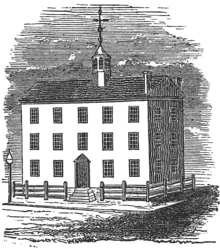 The Stadt Huys in Albany became the state’s first permanent capitol when Albany became the capital in 1797.
The Stadt Huys in Albany became the state’s first permanent capitol when Albany became the capital in 1797.
In 1785, New York City became the national capital and continued as such on and off until 1790; George Washington was inaugurated as the first President of the United States in front of Federal Hall in 1789. From statehood to 1797, the Legislature frequently moved the state capital between Albany, Kingston, Poughkeepsie, and New York City. Thereafter, Albany retained that role.
In the early 19th century, New York became a center for advancement in transportation. In 1807, Robert Fulton initiated a steamboat line from New York to Albany, the first successful enterprise of its kind. By 1815, Albany was the state’s turnpike center, which established the city as the hub for pioneers migrating west to Buffalo and the Michigan Territory.
In 1825 the Erie Canal opened, securing the state’s economic dominance. Its impact was enormous: one source stated, “Linking the Atlantic Ocean and the Great Lakes, the canal was an act of political will that joined the regions of the state, created a vast economic hinterland for New York City, and established a ready market for agricultural products from the state’s interior.” In that year western New York transitioned from “frontier” to settled area. By this time, all counties and most municipalities had incorporated, approximately matching the state’s is organized today. In 1831, the Mohawk and Hudson Railroad started the country’s first successful regularly–scheduled steam railroad service.
Advancing transportation quickly led to settlement of the fertile Mohawk and Gennessee valleys and the Niagara Frontier. Buffalo and Rochester became boomtowns. Significant migration of New England “Yankees” (mainly of English descent) to the central and western parts of the state led to minor conflicts with the more settled “Yorkers” (mainly of German, Dutch, and Scottish descent). More than 15% of the state’s 1850 population had been born in New England. The western part of the state grew fastest at this time. By 1840, New York was home to seven of the nation’s thirty largest cities.
New York culture bloomed in the first half of the 19th century: in 1809 Washington Irving wrote the satirical A History of New Yorkunder the pen name Deitrich Knickerbocker, and in 1819 he based Rip Van Winkle and The Legend of Sleepy Hollow in Hudson Valley towns; Thomas Cole‘s Hudson River school established itself in the 1830s by showcasing dramatic landscapes of the Hudson Valley. The first baseball teams formed in New York City in the 1840s, including the New York Knickerbockers. Professional baseball later located its Hall of Fame in Cooperstown. Saratoga Race Course, an annual summer attraction in Saratoga Springs, opened in 1847.
Civil War
Hundreds of thousands of New York’s young men fought during the Civil War, more than any other Northern state. A war was not in the best interest of business, because much of New York’s trade was based on moving Southern goods. The city’s large Democratcommunity feared the impact of Abraham Lincoln‘s election in 1860. By the time of the 1861 Battle of Fort Sumter, political differences had vanished and the state quickly met Lincoln’s request for soldiers and supplies. While no battles were waged in New York, the state wasn’t immune to Confederate conspiracies, including one to burn various New York cities and another to invade the state via Canada.
In 1863, Lincoln issued the Emancipation Proclamation, which freed the slaves in states that were still in rebellion against the union. In March 1863, the federal draft law was changed so that male citizens between 20 and 35 and unmarried citizens to age 45 were subject to conscription. Those who could afford to hire a substitute or pay $300 were exempt. Antiwar newspaper editors attacked the law. Democratic Party leaders raised the specter of a deluge of southern blacks. On the lottery’s first day, July 11, 1863, the first lottery law was held. On Monday, July 13, 1863, five days of large-scale riots began.
Civil War to the turn of the century
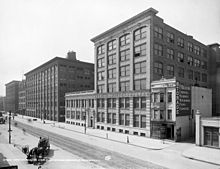 Companies such as Eastman Kodak(Rochester headquarters pictured ca. 1900)epitomized New York’s manufacturing economy in the late 19th century.
Companies such as Eastman Kodak(Rochester headquarters pictured ca. 1900)epitomized New York’s manufacturing economy in the late 19th century.
In the following decades, New York strengthened its dominance of the financial and banking industries. Manufacturing continued to rise: Eastman Kodak in Rochester, General Electricin Schenectady, and Endicott-Johnson Shoe Company in the Triple Cities are some of the well-known companies founded during that time. Buffalo and Niagara Falls attracted numerous factories following the advent of hydroelectric power in the area. With industry blooming, workers began to unite in New York as early as the 1820s. By 1882, the Knights of Labor in New York City had 60,000 members. Trade unions were able to use political influence to limit working hours as early as 1867. At the same time, New York’s agricultural output peaked. Focus changed from crop-based to dairy-based agriculture. By 1881, the state had more than 241,000 farms. In the same period, the area around New York harbor became the world’s oyster capital, retaining that title into the early twentieth century.
Immigration increased throughout the latter half of the 19th century. Starting with the Irish potato famine in the 1840s, New York became a prominent entry point for those seeking a new life in the United States. Between 1855 and 1890, an estimated 8 million immigrants passed through Castle Clinton at Battery Park in Manhattan. Early in this period, most immigrants came from Ireland and Germany. Ellis Island opened in 1892, and between 1880 and 1920, most immigrants were German Jews, Poles, and other eastern and southern Europeans. By 1925, New York City’s population outnumbered that of London, making it the most populous city in the world. Arguably New York’s most identifiable symbol, Liberty Enlightening the World (the Statue of Liberty), a gift from France for the American centennial, was completed in 1886. By the early 20th century, the statue was regarded as the “Mother of Exiles”—a symbol of hope to immigrants.
New York’s political pattern changed little after the mid–19th century. New York City was already heavily Democrat and Upstate, Republican. In the 1850s, Democratic Tammany Hall became one of the most powerful and durable political machines in United States history. Boss William Tweed brought the organization to the forefront of city and then state politics in the 1860s. Tammany maintained influence until at least the 1930s. Outside the city, Republicans were able to influence the redistricting process enough to constrain New York City and capture the Legislature in 1894. Both parties have seen political success: in the 39 presidential elections between 1856 and 2010, Republicans won 19 times and Democrats 20 times.
1900 through the Great Depression
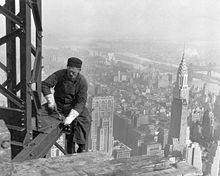 A frameworker tightens bolts on the Empire State Building in 1930; the recently completed Chrysler Building is seen in the background.
A frameworker tightens bolts on the Empire State Building in 1930; the recently completed Chrysler Building is seen in the background.
By 1900, New York was the richest and most populous state. Two years prior, the five boroughs of New York City became one city. Within decades, the city’s emblem had become the skyscraper: the Woolworth Building was the tallest building in the world from 1913, surpassed by 40 Wall Street in April 1930, the Chrysler Building in 1930, the Empire State Building in 1931, and the World Trade Center in 1972 before losing the title in 1974.
In the early 20th century, governor Theodore Roosevelt and fellow Republicans invented Progressivism, later known as “the New York Idea.” “Its main concerns included the righting of social ills, conservation, the discarding of ineffective and corrupt urban government, and control of trusts and other industrial combinations.” Democrats continued the ideology. However, they were “more concerned about factory labor and urban problems and had closer ties to immigrants and organized labor.” Democrats’ efforts in Progressivism impacted the national party: “The Democratic Party developed a new image—at once urban and reform minded, pro-immigrant and welcoming to African Americans—that increasingly defined the northern Democratic Party.”
Following a sharp but short-lived Depression at the beginning of the decade, New York enjoyed a booming economy during the Roaring Twenties. New York suffered during the Great Depression, which began with the Wall Street crash on Black Tuesday in 1929. The Securities and Exchange Commission opened in 1934 to regulate the stock market. Franklin Delano Roosevelt was elected governor in 1928, and the state faced upwards of 25% unemployment. His Temporary Emergency Relief Agency, established in 1931, was the first work relief program in the nation and influenced the national Federal Emergency Relief Administration. Roosevelt was elected President in 1932 in part because of his promises to extend New York–style relief programs across the country via his New Deal. In 1932, Lake Placid was host to the III Olympic Winter Games.


